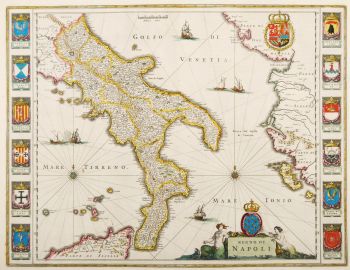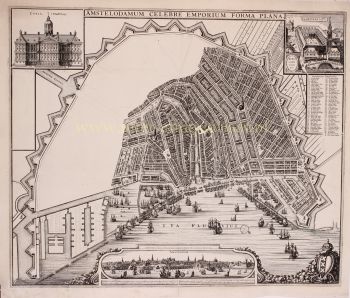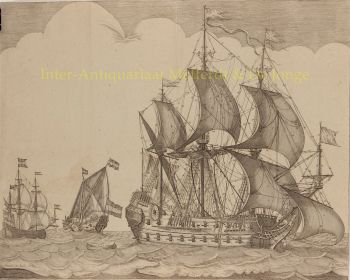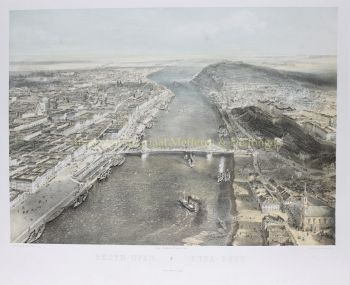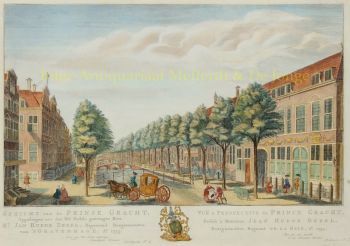Schenkenschans 1649
Joan Blaeu
€ 550
Inter-Antiquariaat Mefferdt & De Jonge
- About the artworkVESTING SCHENKENSCHANS "Schenken-Schans - Het Tolhuis - 't Huis te Hal - Griethuisen - Christina of Nieu Schenkschans" kopergravure vervaardigd voor Joan Blaeu's Stedenboek in of na 1649. In de tijd met de hand gekleurd. Afm. 43 x 52 cm. Vesting Schenkenschans, thans in Duitsland deel van de gemeente Kleef (Kleve), behoorde lange tijd tot Nederland. Tijdens de Tachtigjarige Oorlog kwam het in bezit van de Republiek der Zeven Verenigde Nederlanden. In 1586 werd de vesting door Maarten Schenk van Nydeggen aangelegd. In 1599 werd de schans door Maurits van Oranje versterkt en daarna meteen op de proef gesteld met een belegering door de kardinaal van Oostenrijk. De vesting had een grote betekenis in het strategisch belangrijke gebied rond de splitsing van de rivieren Rijn en Waal en werd als toegangspoort tot de Republiek lange tijd als onneembaar gezien. Prijs: Euro550,-
- About the artist
Joan Blaeu (1596-1673), was born on the 23rd of September in 1596 in Alkmaar.
He was a Dutch cartographer born in Alkmaar. He followed the footsteps of his father, cartographer Willem Blaeu.
In 1620 he became a doctor of law but he joined the work of his father. In 1635 they published the Atlas Novus (full title: Theatrum orbis terrarum, sive, Atlas novus) in two volumes. Joan and his brother Cornelius took over the studio after their father died in 1638. Joan became the official cartographer of the Dutch East India Company.
Blaeu's world map, Nova et Accuratissima Terrarum Orbis Tabula, incorporating the discoveries of Abel Tasman, was published in 1648. This map was revolutionary in that it "depicts the solar system according to the heliocentric theories of Nicolaus Copernicus, which show the earth revolving around the sun.... Although Copernicus's groundbreaking book On the Revolutions of the Spheres had been first printed in 1543, just over a century earlier, Blaeu was the first mapmaker to incorporate this revolutionary heliocentric theory into a map of the world."
Blaeu's map was copied for the map of the world set into the pavement of the Groote Burger-Zaal of the new Amsterdam Town Hall, designed by the Dutch architect Jacob van Campen (now the Amsterdam Royal Palace), in 1655.
Blaeu's Hollandia Nova was also depicted in his Archipelagus Orientalis sive Asiaticus published in 1659 in the Kurfürsten Atlas (Atlas of the Great Elector). and used by Melchisédech Thévenot to produce his map, Hollandia Nova—Terre Australe (1664).
As "Jean Blaeu", he also published the 12 volume "Le Grand Atlas, ou Cosmographie blaviane, en laquelle est exactement descritte la terre, la mer, et le ciel". One edition is dated 1663. That was folio (540 x 340 mm), and contained 593 engraved maps and plates. In March 2015, a copy was on sale for £750,000.
Around 1649 Joan Blaeu published a collection of Dutch city maps named Toonneel der Steeden (Views of Cities). In 1651 he was voted into the Amsterdam council. In 1654 Joan published the first atlas of Scotland, devised by Timothy Pont. In 1662 he reissued the Atlas Novus, also known as Atlas Maior, in 11 volumes, and one for oceans.
A cosmology was planned as their next project, but a fire destroyed the studio completely in 1672.
Joan Blaeu died in Amsterdam the following year, 1673. He was buried in the Westerkerk at Amsterdam.
Are you interested in buying this artwork?
Artwork details
Related artworks
- 1 - 4 / 12
- 1 - 4 / 24
- 1 - 4 / 12





